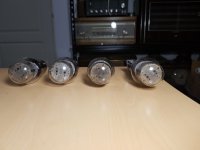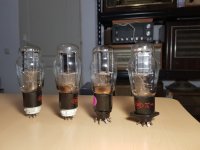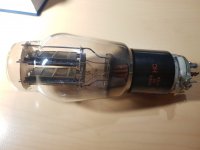Yes, that is true for 2A3s from datasheet but I have found it's significantly less in practice with the 6C4C. To be honest, I normally use transformer coupling for class A1 or a DC coupled cathode follower with 8 mA current (half 6SN7 drives both power tubes easy) but you can see that the Audio Note Neiro uses the 5687 at even lower current around 5 mA (if I remember well) and has no issues with slew/rate etc....
Finally, at 360V/50 mA the 6C4C has certainly lower mu (rp is just over 800R and gm 4.2 mA/V). So, the required driving voltage is more, similar to 300B.
Regarding the sound.....I have not found discernible difference with DC heating between 2A3 and 6A3/6C4C or equivalents. Especially if use regulators for both voltage and current. Differences might arise if there is related IMD that surely one gets with AC heating, independently of hum and filament voltage. For sure higher voltage is more problematic with AC heating.
Does a 2.3K result in better sound than a typical 4-5K? In the case of the Lundahls, for example, the LL1627 vs LL1623 the difference is like night and day. They are equivalent for bass and but LL1627 is miles better above 1KHz. The 1623 does not even make 20KHz decently....of course can find better but as general rule of thumb having half impedance with 2xgm is an advantage. I have made a comparison with the 300B with 2.2K but in reality I would never use it. Never had good results. Also with a 2A3, if you want more watts without entering grid current the only choice is going to higher plate voltage and using higher plate load....The transformer performance also is massively dependent on the size for a given geometry. That means that a smaller 5K transformer, as one would use for a 45 for example, is better than a 5K of larger size. Normally manufacturers do not go for much more complicated geometries to restore high frequency performance, pick one geometry and create a family of transformers. When they go for more complex geometry, the cost of the OPT is much higher.....
Pick your poison!😉
Finally, at 360V/50 mA the 6C4C has certainly lower mu (rp is just over 800R and gm 4.2 mA/V). So, the required driving voltage is more, similar to 300B.
Regarding the sound.....I have not found discernible difference with DC heating between 2A3 and 6A3/6C4C or equivalents. Especially if use regulators for both voltage and current. Differences might arise if there is related IMD that surely one gets with AC heating, independently of hum and filament voltage. For sure higher voltage is more problematic with AC heating.
Does a 2.3K result in better sound than a typical 4-5K? In the case of the Lundahls, for example, the LL1627 vs LL1623 the difference is like night and day. They are equivalent for bass and but LL1627 is miles better above 1KHz. The 1623 does not even make 20KHz decently....of course can find better but as general rule of thumb having half impedance with 2xgm is an advantage. I have made a comparison with the 300B with 2.2K but in reality I would never use it. Never had good results. Also with a 2A3, if you want more watts without entering grid current the only choice is going to higher plate voltage and using higher plate load....The transformer performance also is massively dependent on the size for a given geometry. That means that a smaller 5K transformer, as one would use for a 45 for example, is better than a 5K of larger size. Normally manufacturers do not go for much more complicated geometries to restore high frequency performance, pick one geometry and create a family of transformers. When they go for more complex geometry, the cost of the OPT is much higher.....
Pick your poison!😉
Last edited:
Pick your favorite tube:
Original high count multi filament mono-plate 2A3
Classical double plate 2A3
Modern mono-plate 2A3
6C4C
Or pick another that are similar to the above; your choice.
Each one of the above tubes have:
2 sides to each plate; 2 sides to each grid; and 2 sides to each filament (or 2 sides to the 6C4C cathode).
Look at that tube geometry, draw it out. Each individual single tube has two electron paths, one path on each 'side'
(each individual single tube is actually two tubes in parallel).
Parallel tubes work, even though there is only one plate, one grid, and one cathode/filament inside of a single glass envelope.
Original high count multi filament mono-plate 2A3
Classical double plate 2A3
Modern mono-plate 2A3
6C4C
Or pick another that are similar to the above; your choice.
Each one of the above tubes have:
2 sides to each plate; 2 sides to each grid; and 2 sides to each filament (or 2 sides to the 6C4C cathode).
Look at that tube geometry, draw it out. Each individual single tube has two electron paths, one path on each 'side'
(each individual single tube is actually two tubes in parallel).
Parallel tubes work, even though there is only one plate, one grid, and one cathode/filament inside of a single glass envelope.
Parallel operation of triode tubes can give very good results.
But in order to get very good results, it requires close attention to details.
If any of you can get permission for a reprint, you should get your hands on the very last issue of Glass Audio:
Glass Audio
Volume 12 Number 5 2000
"Paralleling Tubes Effects" (the cover article)
Kamna, McDonald, & Boehlke
600 Measurements of 20 dual triode tubes, with collation and analysis of that data; listening tests at 3 different venues using 3 different loudspeaker pair models; math proofs; and a formal proof using deductive reasoning from examples of many favorite triode tube types.
A presentation of the essence of this article was also presented at one of the VSAC conferences in Silverdale, Washington.
(Vacuum Tube Audio Conference)
Parallel operation if done Improperly has all the Bad characteristics that audiophile fans claim.
. . . Whereas, Parallel operation that is done Properly has all the Good advantages of such operation, and works extremely well.
I remember that article, but I don't have access to it now.
Properly done parallel operation can't be too difficult to describe. What is it, exactly?
- Separate grid stopper resistor for each tube
- Separate cathode bias resistor (+ Ck if desired) or 'cathode stopper' for each tube
- Choose matched tubes to parallel and/or individual plate current adjustment for each tube
The author posted about it on Audio Asylum...
"Done properly, you can have 2X, 3X, and 4X the power, at the same distortion. There are some "secrets" to doing the circuit very simply, very few more parts. You do not need to go to the extremes that I see posted.
AND YOU CAN HAVE WIDER BANDWIDTH TOO."
Last edited:
rongon,
Please read my Post # 32 of this thread.
It has a good example of things you need to pay attention to when paralleling tubes.
Even if you use a different method than that, at least all the issues are covered, and mentioned, or alluded to in that example.
Please read my Post # 32 of this thread.
It has a good example of things you need to pay attention to when paralleling tubes.
Even if you use a different method than that, at least all the issues are covered, and mentioned, or alluded to in that example.
I remember that once I read on a blog that 6C4C is doing well at 18 Watts plate dissipation and only an 22-23 watts they have "cherry" plate@klauss00,
if you really want some power from 2A3 PSE without going into grid current (class A2) and without spending a fortune in tubes I suggest a tried and tested (by myself) solution: 6C4C PSE (equivalent to 6B4G but better specs) with Lundahl LL1627/90 mA and 2.3K plate load. I had this amp for a couple of years and then sold it. It was very good. I still have one more pair of LL1627. Maybe I build another one...
The 6C4C is built like a tank, in fact max specified anode voltage is 360V vs 300V of all other 2A3/6A3/6B4G types. You can run it at 18W plate dissipation without problems and it will last at least 6000-7000 hours, possibly 10000....
At me Rp is 750 ohms and OT load 5K this meaning 120pF Miller Effect Capacitance. Do you think that my driver with WE 417a and a copy of Lundahl LL1660 will be able to handle this Miller capacitance value?2A3 grid to plate 16.5 pF
2A3 rp = 800 Ohms
2A3 u = 4.2
Primary 2500 Ohms; (2500/(2500 + 800)) x 4.2 = gain of 3.8
16.5 pF x 3.8 = Miller Effect capacitance of 62.7 pF
(one 2A3 62.7pF; But 125.4pF for parallel 2A3 tubes).
The driver has to drive 125pF.
That is a lot more than a single 300B Miller Effect capacitance.
Mine are 6B4G classical dual plate. In theory they are two type 45 tube wired in parallel in the same glass bulbPick your favorite tube:
Original high count multi filament mono-plate 2A3
Classical double plate 2A3
Modern mono-plate 2A3
6C4C
Or pick another that are similar to the above; your choice.
Each one of the above tubes have:
2 sides to each plate; 2 sides to each grid; and 2 sides to each filament (or 2 sides to the 6C4C cathode).
Look at that tube geometry, draw it out. Each individual single tube has two electron paths, one path on each 'side'
(each individual single tube is actually two tubes in parallel).
Parallel tubes work, even though there is only one plate, one grid, and one cathode/filament inside of a single glass envelope.
Regarding to PSU, I want to be with low DCR and with a tube rectifier with low voltage drop (less sag). Topology CLCLC first chock Hammond 193S and second Hammond 159y or 159v. Starting from this I have 4 tube rectifier possibilities:
1. two GZ34/5AR4
V drop at 150 mA per plate 11v per plate
Total plate supply resistance per plate min. 50 ohms
2. one 5AU4
V drop at 150 mA per plate 27v per plate
Total plate supply resistance per plate 30 ohms
3. two type 83 mercury rectifier
V drop 15v independently by current
Total plate supply resistance per plate in full wave rectifier it is not specified but in half wave rectifier need to add 100 ohms resistor in series with each plate.
an RF choke need to be placed in series with each plate in order to cancel RF noise
4, two 866A
here sky is the limit
very low experience with this tube on internet.
At a first glance I am tempted to choose type 83
1. two GZ34/5AR4
V drop at 150 mA per plate 11v per plate
Total plate supply resistance per plate min. 50 ohms
2. one 5AU4
V drop at 150 mA per plate 27v per plate
Total plate supply resistance per plate 30 ohms
3. two type 83 mercury rectifier
V drop 15v independently by current
Total plate supply resistance per plate in full wave rectifier it is not specified but in half wave rectifier need to add 100 ohms resistor in series with each plate.
an RF choke need to be placed in series with each plate in order to cancel RF noise
4, two 866A
here sky is the limit
very low experience with this tube on internet.
At a first glance I am tempted to choose type 83
I'd add to that list a couple of PY500A damper diodes. Very low internal resistance, high current capabilities.
Agreed, EY500 would be better, yes, 6.3V heater. Those are rarer though, and command a bit of a premium.
If you don't mind mercury, I used several times AX50.
Full wave mercury vapour rectifier, 4V/3.75A direct heated, 500Veff, 275mA with 15V fixed drop.
Full wave mercury vapour rectifier, 4V/3.75A direct heated, 500Veff, 275mA with 15V fixed drop.
Do you have any idea about total plate supply resistance per plate for PY500A?I'd add to that list a couple of PY500A damper diodes. Very low internal resistance, high current capabilities.
- Home
- Amplifiers
- Tubes / Valves
- 2A3 SE parallel


